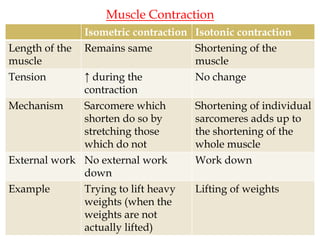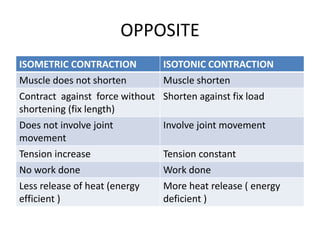Between Isotonic and Isometric Which Uses More Muscle Fibers
The forcevelocity relationship of muscle indicates that muscle force drops greatly from its isometric level when muscle fibers shorten rapidly during concentric contractions and rises to a plateau almost double its isometric level when muscle fibers lengthen rapidly during eccentric contractions Fig. An example can be found when the muscles of the hand and forearm grip an object.

Isotonic Isometric Contraction
Myosin head uses this energy to tip back into its high-energy position.

. Sedentary A basketball player who chooses to do exercises that help to improve lateral movement cardiorespiratory endurance and vertical leap is abiding by the fitness principle. However these responses are not identical. It cleaves ATP into ADP and phosphate ion.
Isometric and Isotonic Contraction. Part of myosin head is an ATPase. An isometric contraction of a muscle generates tension without changing length.
Isotonic exercise differs from isometric exercise in that there is movement of a joint during the muscle contraction. 2857-2875 2010-The quest to increase lean body mass is widely pursued by those who lift weights. An increase in the size of a muscle a endurance aerobic b hypertrophy c isometric d isotonic e latent f motor unit g muscle fatigue h.
Definition and Examples 639 Muscle Metabolism. It uses the force of gravity in the form of weighted bars dumbbells or weight stacks in order to oppose the force generated by muscle through concentric or eccentric contractionWeight training uses a variety of specialized equipment to target specific muscle. A classic example of an isotonic exercise is weight training with dumbbells and barbells.
More force is generated with slower movement. Muscle length stays same but tension increases 420 OSMOSISORG Figure 498 Muscle contraction. Think of knee.
A neuromuscular junction contains an-motor end plate-synaptic cleft. The tetanic contractions of motor units are the effect of repetitive activations of muscle fibers and the summation of responses to successive stimuli. Single leg bridges are held for 10 seconds at a time.
In isotonic contraction the tension in the muscle remains constant despite a. Studies have shown that average Americans spend more than half of their waking day in _____ activities such as using a computer studying or watching television. J Strength Cond Res 2410.
Weight training is a common type of strength training for developing the strength and size of skeletal muscles. Research is lacking however as to the best approach for maximizing exercise-induced muscle growth. Single leg bridges are a more advanced core stability exercise and should be performed for both involved and uninvolved extremities.
As the strength of the signal increases more motor units are excited in addition to larger ones with the largest motor units having as much as 50 times the. Core muscle group training includes bridges using bilateral lower extremities which progress to bridges with single limb support and alternate leg extension. The Danis-Weber classification system uses the position of the level of the fibular fracture in its relationship to its height at the ankle.
The joints of the hand do not move but muscles generate sufficient force to prevent the object from being dropped. Speed of shortening. In an isotonic contraction the muscle fibers _____ resulting in the movement.
The mechanisms of muscle hypertrophy and their application to resistance training. Academiaedu is a platform for academics to share research papers. Most muscles work at a mechanical disadvantage due to the position of the muscle insertion point in relation to the portion of the limb being moved.
Synthesis of ATP 1017 Skeletal Muscle Fibers. In more simple terms Danis-Weber Classification. As the weight is lifted throughout the range of motion the muscle shortens and lengthens.
Calisthenics are also an example of isotonic. Originally it was revealed by calculating the difference between the contraction evoked by n1 stimuli and the contraction evoked by n stimuli Stein and Parmiggiani 1979 1981. A dynamic isotonic muscle action produces more force than a static isometric contraction.
Type C 2 fractures result from a combination of abduction and external rotation producing more extensive syndesmotic injury and a higher fibular fracture. Muscle length changes but tension stays same Isometric. Types and Functions 947.
Each muscle fiber develops more myofibrils and each myofibril contains a larger number of _____. Muscle contraction 2 Multiple fiber summation When a weak signal is sent by the CNS to contract a muscle the smaller motor units being more excitable than the larger ones are stimulated first.

What Are Isometric Exercises Learn More In This Article Exercise Hand Exercises Isometric Exercises

From Wikiwand Muscle Contraction Muscle Contraction Types Of Muscles Muscular System Anatomy
No comments for "Between Isotonic and Isometric Which Uses More Muscle Fibers"
Post a Comment